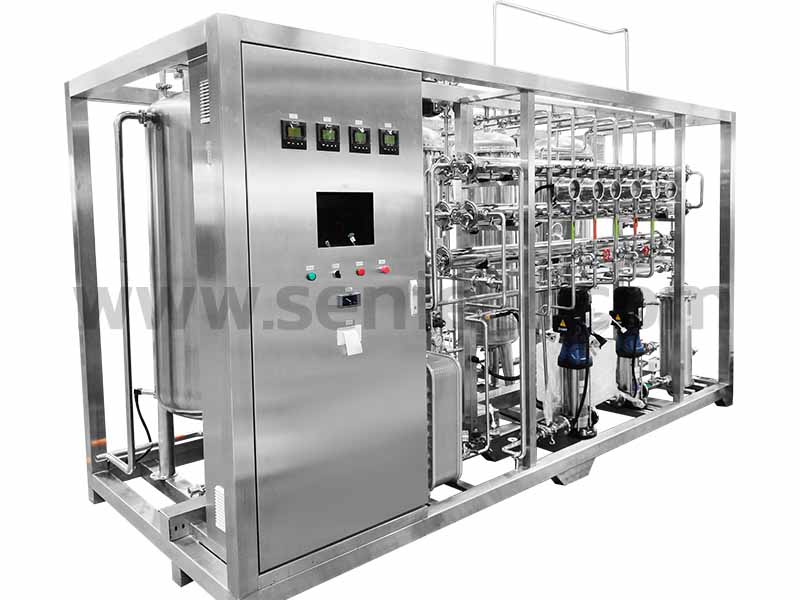The solution to the high conductivity of purified water equipment is actually very simple. First, test the raw water quality to check whether the water quality has changed. If the raw water changes greatly, the raw water needs to be treated accordingly. Secondly, check whether the activated carbon in the pretreatment device is invalid, and if it fails, replace the activated carbon in time. Then check the RO membrane elements and filter elements of the purified water equipment, and clean or replace them in time. Finally, regular maintenance and maintenance of purified water equipment.
Purified water equipment is mainly used in biochemistry, pharmaceutical factories, hospitals, laboratories and other industries, and the quality of the effluent water must meet the water demand of these enterprises. The core technology adopted by the purified water equipment is the combination of reverse osmosis technology and EDI technology, which ensures the stable water quality of the purified water equipment and the stable operation of the system, which is suitable for the actual needs of enterprise development and production.
Part 1 Water Quality Standards For Pharmaceutical Water
Purified water should meet the purified water standards recorded in the Chinese Pharmacopoeia, the United States Pharmacopoeia, and the European Pharmacopoeia. Hygienic inspection requires that the microbial level is lower than 10CFU/100ml, the endotoxin level is lower than 0.25EU/ml, and the electrical conductivity is ≤2μS/cm. Water for injection should meet the standards for water for injection recorded in the Chinese Pharmacopoeia. When preparing purified water, online detection is usually used to measure the conductivity of purified water to reflect the concentration of various ions in the water.

Part 2 Functional Characteristics Of Pharmaceutical Purified Water Equipment
The pharmaceutical purified water equipment adopts fully automatic welding process, no dead angle design, and the surface is chrome-plated, which can effectively prevent equipment corrosion and prevent rust. The whole set of equipment supports fully automatic control, and the man-machine interface is equipped with touch screen control, which can monitor water quality online, detect flow, pressure and other data. The system follows safety principles and has safety functions such as anhydrous protection and pressure protection to ensure stable and safe operation of the system. The pharmaceutical purified water equipment adopts reverse osmosis technology, and the reverse osmosis system has an automatic cleaning function, which guarantees reliable water quality. With a complete emergency plan, it can realize online maintenance and alarm data parameter recording functions. Key alarm information will be sent to relevant personnel in time to ensure that equipment failures are handled in a timely manner.
In general, the high conductivity of pure water equipment means that the entire water treatment system is consistent with the initial state and has not changed. At this time, the reason for the high conductivity is that the desalination rate of the reverse osmosis membrane components decreases due to the aging of the reverse osmosis membrane components. The correct solution is to replace the reverse osmosis membrane of the reverse osmosis host. Usually, the replacement frequency (period) is once every 2-3 years.
Other Situations:
1.During normal operation of the equipment, the electrical conductivity suddenly rises, and the displacement increases. This situation is due to the sharp increase in conductivity caused by the leakage of the sealing ring connected to the reverse osmosis membrane module. It is recommended to replace the sealing ring. The specific method is to detect the water quality of each membrane module, find out the leaking part and replace it.
2.When the equipment is turned on, the secondary conductance rises and it is difficult to drop or the drop takes too long. This situation is generally common in double-stage reverse osmosis, and sodium hydroxide is usually added between the first and second stages to adjust Measures for the removal of carbon dioxide in water, the amount of sodium hydroxide added is related to the conductivity, it is recommended to adjust the amount added.
3.After the equipment has been in operation for a period of time, the water production volume does not change, the conductivity increases, and the drainage volume increases. It shows that the membrane is degraded by the oxidizing medium, the conductivity increases, and the membrane module needs to be replaced.
4.The sand carbon purification and filtration effect of the equipment pretreatment is reduced or invalid, and there is no regular and timely backwash (the conductivity of the influent water will increase relatively).
5.The security filter of the RO water inlet is dirty and blocked due to the large pressure difference and has not been replaced in time.
In addition, the reverse osmosis equipment is a large system and there are other factors. After a problem occurs, keep daily operation records and contact the manufacturer to analyze the problem. The equipment manufacturer is familiar with the equipment system and can quickly find out the problem. The raw water pretreatment is not up to standard, resulting in poor water quality of the reverse osmosis equipment; there may also be damage to the RO membrane in the reverse osmosis equipment, resulting in salt leakage. In the example, there is another possibility that the installation of the reverse osmosis membrane is reversed. It can detect whether the effluent water quality of the water making equipment has deteriorated. If so, it is time to change the filter membrane.










